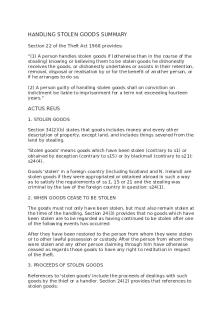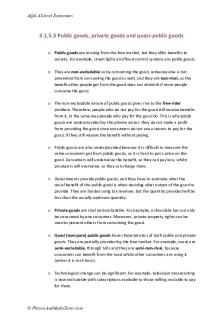C) Public goods, private goods and quasi-public goods PDF

| Title | C) Public goods, private goods and quasi-public goods |
|---|---|
| Course | Economics |
| Institution | University College London |
| Pages | 1 |
| File Size | 66.3 KB |
| File Type | |
| Total Downloads | 96 |
| Total Views | 164 |
Summary
Download C) Public goods, private goods and quasi-public goods PDF
Description
AQA AS-level Economics
3.1.5.3 Public goods, private goods and quasi-public goods o Public goods are missing from the free market, but they offer benefits to society. For example, street lights and flood control systems are public goods. o They are non-excludable so by consuming the good, someone else is not prevented from consuming the good as well, and they are non-rival, so the benefit other people get from the good does not diminish if more people consume the good. o The non-excludable nature of public goods gives rise to the free-rider problem. Therefore, people who do not pay for the good still receive benefits from it, in the same way people who pay for the good do. This is why public goods are underprovided by the private sector: they do not make a profit from providing the good since consumers do not see a reason to pay for the good, if they still receive the benefit without paying. o Public goods are also underprovided because it is difficult to measure the value consumers get from public goods, so it is hard to put a price on the good. Consumers will undervalue the benefit, so they can pay less, whilst producers will overvalue, so they can charge more. o Governments provide public goods, and they have to estimate what the social benefit of the public good is when deciding what output of the good to provide. They are funded using tax revenue, but the quantity provided will be less than the socially optimum quantity. o Private goods are rival and excludable. For example, a chocolate bar can only be consumed by one consumer. Moreover, private property rights can be used to prevent others from consuming the good. o Quasi (non-pure) public goods have characteristics of both public and private goods. They are partially provided by the free market. For example, roads are semi-excludable, through tolls and they are semi-non-rival, because consumers can benefit from the road whilst other consumers are using it (unless it is rush hour). o Technological change can be significant. For example, television broadcasting is now excludable with subscriptions available to those willing and able to pay for them.
© PhysicsAndMathsTutor.com...
Similar Free PDFs

Public Goods and Common Resources
- 18 Pages

Goods and Pricing Chapter 14
- 6 Pages

E) Merit and demerit goods
- 2 Pages

E) Merit and demerit goods
- 1 Pages

Sales and Supply of goods
- 12 Pages

Handling stolen goods
- 3 Pages

Sell Goods Okkkk
- 7 Pages

Sales of Goods Act
- 7 Pages
Popular Institutions
- Tinajero National High School - Annex
- Politeknik Caltex Riau
- Yokohama City University
- SGT University
- University of Al-Qadisiyah
- Divine Word College of Vigan
- Techniek College Rotterdam
- Universidade de Santiago
- Universiti Teknologi MARA Cawangan Johor Kampus Pasir Gudang
- Poltekkes Kemenkes Yogyakarta
- Baguio City National High School
- Colegio san marcos
- preparatoria uno
- Centro de Bachillerato Tecnológico Industrial y de Servicios No. 107
- Dalian Maritime University
- Quang Trung Secondary School
- Colegio Tecnológico en Informática
- Corporación Regional de Educación Superior
- Grupo CEDVA
- Dar Al Uloom University
- Centro de Estudios Preuniversitarios de la Universidad Nacional de Ingeniería
- 上智大学
- Aakash International School, Nuna Majara
- San Felipe Neri Catholic School
- Kang Chiao International School - New Taipei City
- Misamis Occidental National High School
- Institución Educativa Escuela Normal Juan Ladrilleros
- Kolehiyo ng Pantukan
- Batanes State College
- Instituto Continental
- Sekolah Menengah Kejuruan Kesehatan Kaltara (Tarakan)
- Colegio de La Inmaculada Concepcion - Cebu







